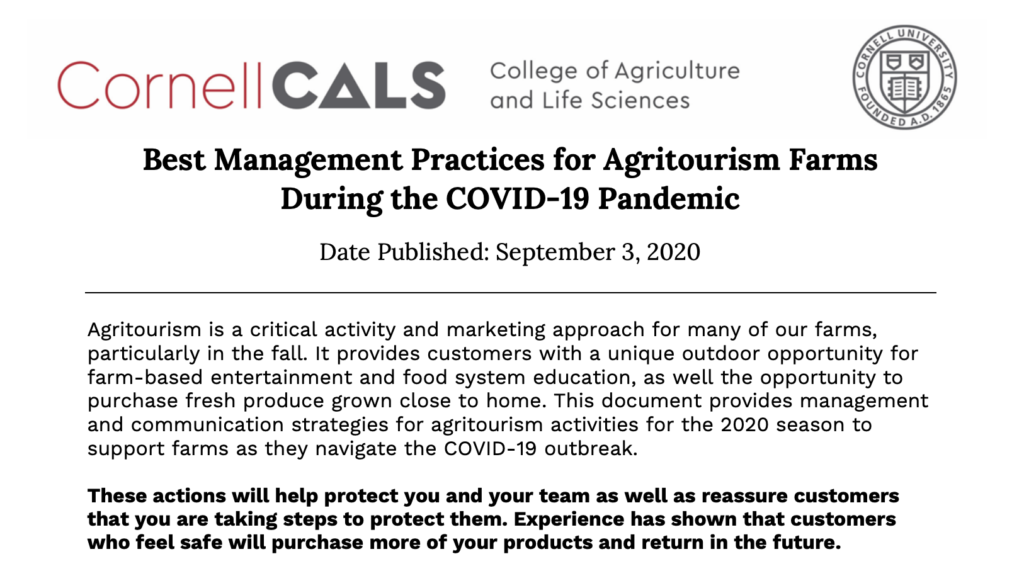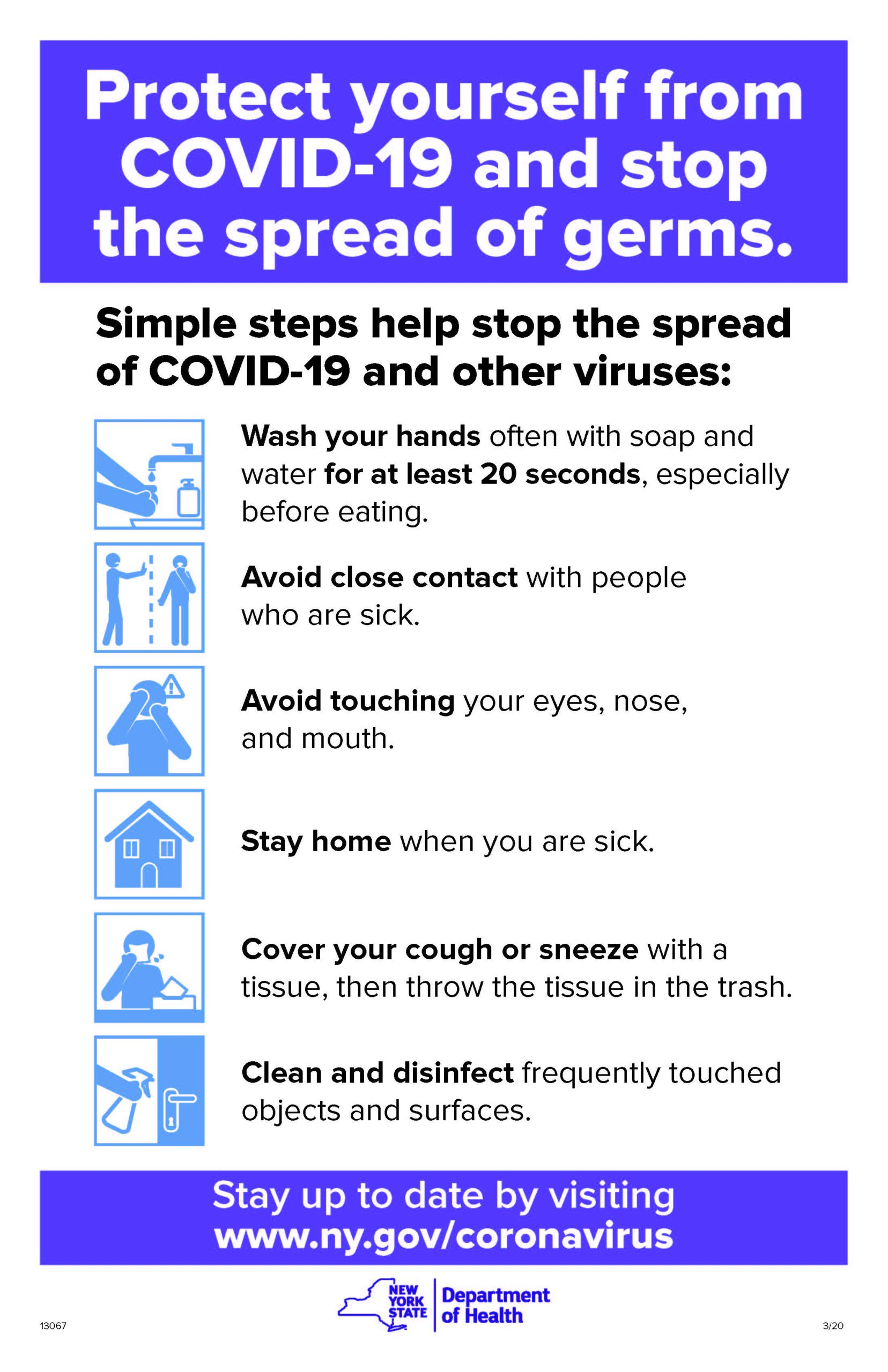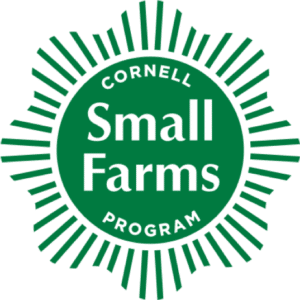Best Management Practices for Agritourism Farms During the COVID-19 Pandemic
Date Published: September 3, 2020
Agritourism is a critical activity and marketing approach for many of our farms, particularly in the fall. It provides customers with a unique outdoor opportunity for farm-based entertainment and food system education, as well the opportunity to purchase fresh produce grown close to home. This document provides management and communication strategies for agritourism activities for the 2020 season to support farms as they navigate the COVID-19 outbreak.
These actions will help protect you and your team as well as reassure customers that you are taking steps to protect them. Experience has shown that customers who feel safe will purchase more of your products and return in the future.
Facts about the SARS-CoV-2 Virus that Causes COVID-19
- The virus is predominantly transmitted person to person through respiratory droplets, which is why 6-foot physical distancing and wearing cloth face coverings are so important.
- Cloth face coverings reduce spread of the virus by those who may be infected even if they are not showing symptoms. These must be worn in addition to physical distancing.
- The virus can persist on surfaces which is why sanitation of commonly touched surfaces and frequent handwashing are important.
- Risks of infection from touching surfaces can be significantly reduced by frequent handwashing, use of hand sanitizers, and by not touching one’s face.
- The virus is not transmitted by consuming food.
As an agritourism farm manager, you will need to adjust your business practices to reduce risks and protect your team and customers against virus transmission until state health authorities have determined that the pandemic has subsided.
If you are unable to implement these COVID-19 recommendations, you may decide not to open your agritourism events this year.
If key team members are in a high-risk category for contracting COVID-19 and their presence is required on the farm, then it may be prudent to consider alternatives for this season.
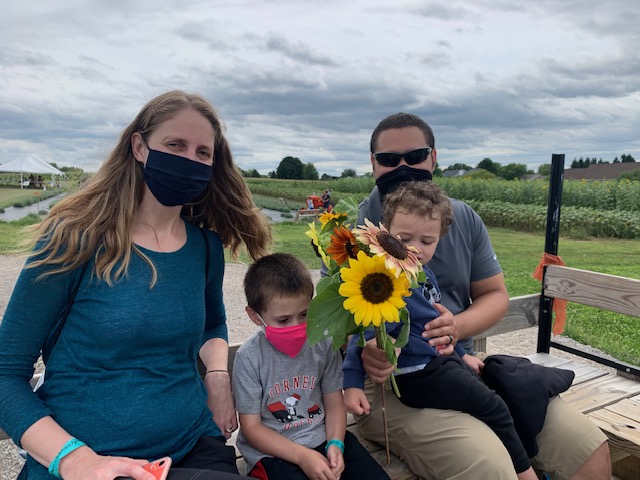
Alternatives to Re-Opening Fully
- Consider a drive through farm tour "safari."
- Increase direct sales of products through farm stands or curbside pickup.
- Develop online sales. The Cornell Small Farms Program has shared ideas on getting started.
- Build an online "virtual" tour of your farm.
- Provide only U-Pick activities. The Cornell Small Farms Program has published BMPs.
Remember that NYS is re-opening in phases and different regions may have different rules about when recreational and tourism-related activities can reconvene. If COVID-19 cases increase, certain activities may need to be restricted or closed. Regularly check the NY Forward reopening guidelines and NYS Department of Agriculture and Markets to ensure your business remains in compliance. As part of Phase IV Reopening, low-risk outdoor arts and entertainment activities are allowed with the following requirements:
- For outdoor spaces, require that all visitors and employees maintain 6-foot physical distance and wear a face covering if physical distancing (6 ft) cannot be maintained, except when seated and eating.
- Maintain visitor presence at 33% or less of maximum capacity. Many farms may not know their normal maximum outdoor capacity. In this case follow state guidelines to set up the farm to allow for social distancing. This will help each farm identify how many individuals or groups (cohorts) can safety be on the farm at any one time. Use this number as your COVID-19 capacity (see below for how to calculate this capacity).
All NY farms must have completed a plan to reopen, even if the business has been open throughout NY PAUSE. This plan must include compliance with applicable guidance for food and non-food businesses, including restaurant and retail activity. All businesses in NYS must complete this plan and have it available at their place of business. See the links at the end of this document for support with developing these plans.
As you prepare for this agritourism season during the COVID-19 pandemic, you must:
- Develop a communication strategy to inform customers about new COVID-19 customer capacity and agritourism practices.
- Train your employees on new COVID-19 procedures and policies.
- Design outdoor entertainment options, strategies and customer flow to maintain physical distance and control number of customers at all activities at any given time.
- Provide adequate handwashing and hand sanitizing facilities for employees and customers.
- Increase the frequency of cleaning and sanitizing frequently touched surfaces.
- Stay up-to-date on current COVID-19 recommendations from the CDC and your state departments of agriculture and health.
1. Develop a communication strategy to inform customers about new COVID-19 customer capacity and agritourism practices.
NY farmers have already done a terrific job at adapting to the challenges of COVID-19 on their farms and at all of their direct marketing venues. Critical to these successes have been robust communication plans that provide customers and employees with a clear understanding of expectations and protocols.
As you plan for your agritourism opening, share the proactive steps you are taking to protect everyone’s health and safety on the farm. Clearly state the need for them to cooperate with new farm rules during this pandemic. This will build trust with both new and returning customers and enhance communication channels for the future. Use multiple outlets including websites, social media, phone messages, farm signage, newsletters, and radio and newspaper ads to connect with your customers and your community.
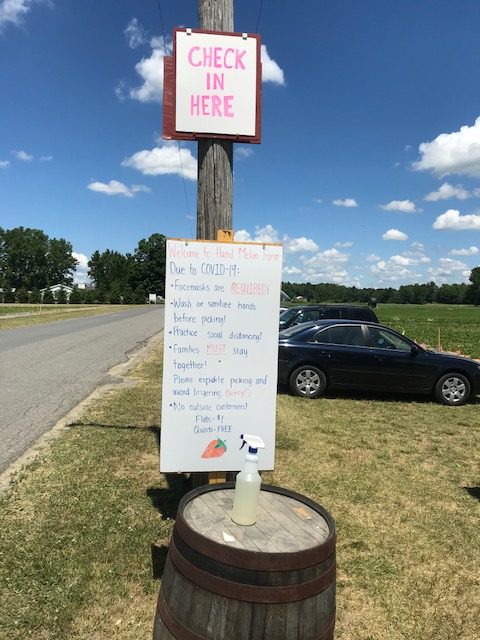
This year, however, you will need to limit the number of customers on the farm at any one time. You may want to limit advertising to focus on your core repeat customers and ensure they have a safe and enjoyable visit. Or, if advertising widely, you may want to establish a way to schedule visit times or provide real time updates that show capacity levels.
Calculate your COVID-19 customer capacity.
To ensure that physical distancing can be maintained, each farm should set a COVID-19 capacity of customers they can manage at one time.
To make a general estimate of your COVID-19 capacity, consider the total outdoor area customers may access. Focus on the fields where activities are located (e.g. corn maze, U-pick fields, picnic areas). During the pandemic, aim for 33% of your typical customer capacity. You may have other limitations that would govern your COVID-19 capacity (e.g. parking, restrooms, indoor areas, etc.).
Estimating COVID-19 Capacity
- Method 1: To estimate the total number of individuals, divide the total outdoor area customers may access by 100 square feet, to allow for physical distancing.
- Method 2: To estimate the total number groups, divide the total outdoor area customers may access by 250 square feet, which estimates groups of 4 people allowing for physical distancing.
- Method 3: Once your parking area is 1/3 full, you are at capacity.
- Method 4: Assess your own space allowing for customers to maintain a distance of 6 feet from other individuals and groups. This can be done for a combination of indoor and outdoor spaces as long as distancing can be maintained in all areas that customers frequent.
Manage customer numbers and payments on the farm.
- Create an online appointment booking system to for customers who want to come to the farm. Your customers will appreciate this sense of safety. This practice will allow you to:
- Control overall customer capacity at any one time.
- Create a flat fee for farm visits, given potential loss of customers. Consider a higher, all-inclusive rate to eliminate separate tickets for different events.
- Reduce the number of payment transactions at the farm entrance by having customers select visit dates and pay in advance.
- Manage the number of customers who want to attend different demonstrations (e.g. draft horse pulls, pumpkin cannons).
- Improve staffing for days or times with higher customer numbers.
- Designate specific hours only for those most vulnerable to COVID-19 infection and their companions (i.e., elderly or those with compromised immune systems).
- Some online booking platforms include: Vagaro, SquareUp, Calendly, Acuity Scheduling (part of Squarespace), Appointlet, Setmore.
- If no pre-booking is available:
- Post the COVID-19 capacity for customers allowed on the farm as well as on websites, social media and outgoing phone messages.
- Real time notifications are essential to manage customer expectations and capacity.
- Post the busiest hours in media communications along with expected wait times.
- No bus tours of unrelated individuals should be accepted (per NY Forward guidance).
- Dedicate trained hospitality employees to monitor and control traffic flow on to the farm and to limit customer entry when at max capacity.
- When the farm reaches the COVID-19 capacity, instruct customers to return at a different time when you expect there to be available space.
- Post the COVID-19 capacity for customers allowed on the farm as well as on websites, social media and outgoing phone messages.
- Prepare to accept credit cards/tap to pay or electronic payments (e.g. Paypal, Venmo, Square, Apple Pay, Cash App) to reduce your team’s exposure from handling cash and coins.
Build a communication campaign that includes the following:
- The COVID-19 number of customers to be allowed on the farm at one time.
- Real time updates as to customer numbers and wait times, special hours, pre-picked produce availability, closings, and farm retail hours.
- Customers should not come to the farm if they are displaying symptoms of COVID-19 or any contagious illness (e.g., fever, vomiting, diarrhea, coughing, fatigue, body aches), or have been in contact with someone who has these symptoms.
- Customers who have traveled to any state on the NYS COVID-19 Travel Advisory List in the last 14 days cannot come to the farm.
- Customers will not be allowed to enter the farm if they are displaying symptoms, have been exposed to someone with COVID-19 or if they have been traveling to states on the NYS Travel Advisory list.
- Customers will be required to maintain a 6-foot physical distance and wear cloth face coverings when distance cannot be maintained.
- Only a certain number of groups will be allowed at any activity at one time.
- Families, including children, or groups must stay close together.
- Additional handwashing and hand sanitizer stations are available for their use while at the farm.
- Pets are not allowed on the farm.
- All customers will be required to verbally confirm that they understand and will cooperate with these new requirements before they may enter the farm.
Post signs reinforcing new practices.
- Post signs at the farm entry:
- Customers who have symptoms or have been exposed to someone with COVID-19 should not enter the farm.
- Customers who have traveled to a state on the NY travel advisory list in the last 14 days should not enter the farm.
- Customers displaying COVID-19 symptoms will be asked to leave.
- Customers must wear cloth face coverings; if they refuse, they will be asked to leave.
- Farm COVID-19 capacity or group size allowed.
- Post “Stop the Spread” signs around the farm, in multiple languages.
- https://on.ny.gov/3bH6gXj
- https://bit.ly/2RYLhqN
- https://bit.ly/2XWBUMf
- For signs in other languages: https://on.ny.gov/2R4kmcB
- For all activities, post signs to indicate customer flow as well as waiting areas
- Mark walkways with crowd control barriers.
- Demonstrate flow with directional arrow signs
- Mark waiting areas with 6 foot distancing
- Clearly mark curb-side pickup, if relevant, and post instructions for drivers awaiting pickup (e.g., call this number for an order to be brought out to you.)
-
2. Train your employees on new COVID-19 procedures and policies.
Farm managers will see better customer compliance when employees are demonstrating the desired behaviors of wearing face coverings and maintaining 6-foot physical distance. Leading by example is essential; your own adherence to these recommended behaviors will set the example and ensure better employee compliance.
NYS guidance requires that all employees who interact with the public must wear face coverings and observe the 6-foot physical distance. These rules apply to both paid employees and unpaid volunteers or family members who are interacting with the public. Face coverings must be provided by the employer.
Prior to opening for customers, schedule training sessions to ensure that all employees fully understand both your specific plan as well as all relevant federal and state guidelines.
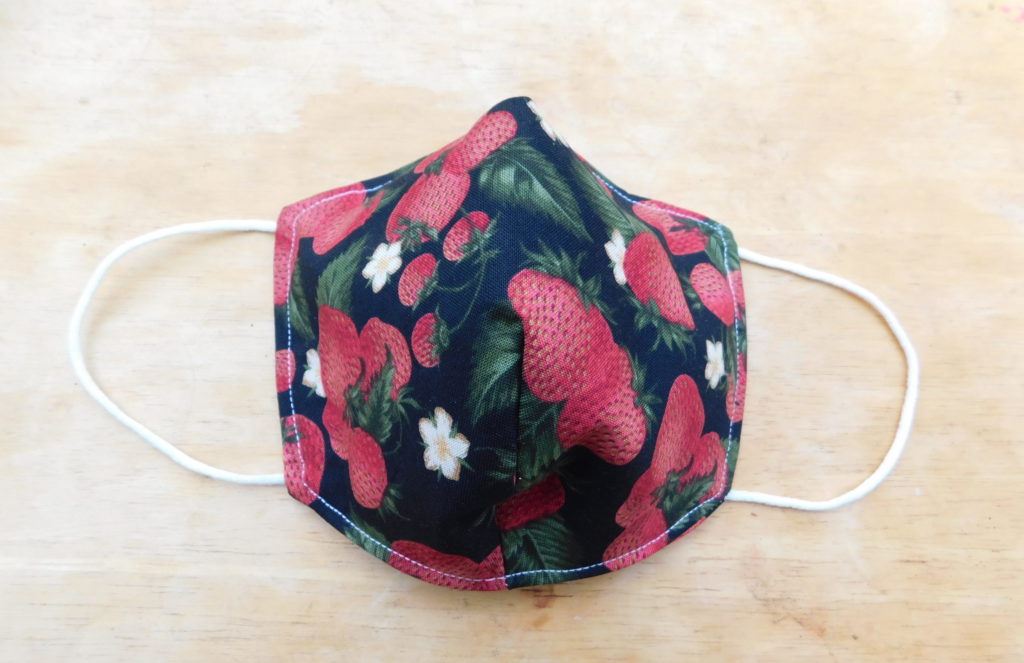
Alert employees to required daily health checks
- Prior to employees starting work, ask them to perform a daily wellness screening following city, county, and state guidance on primary symptoms for COVID-19. At a minimum, wellness screenings should include the following questions:
- Have you developed any of the following symptoms?
- Shortness of breath or trouble breathing
- Cough
- Fever
- Any other symptoms that might indicate you are ill
- In the last 14 days, have you been exposed anyone who is sick or has been diagnosed with COVID-19?
- Have you traveled to any state on the NYS COVID-19 travel advisory list in the last 14 days?
Train your employees to:
- Properly use, store, and wash their cloth face covering. Contact your local Cornell Cooperative Extension office to access free cloth face coverings and hand sanitizer.
- Cornell guidelines: https://bit.ly/3cHU1tr
- Hands should be washed before putting mask on and after removal.
- Avoid touching cloth portions of mask; handle by ear bands only.
- Properly wash and sanitize hands as recommended for general food safety.
- Wash hands upon arriving at work, before and after eating, after using the restroom.
- Put on, remove, and use disposable gloves properly:
- Proper glove donning: https://bit.ly/3lPnmHA
- Proper glove removal: https://bit.ly/2YZyckv
- Remove all jewelry.
- Wash hands before putting on new gloves.
- Remove gloves before breaks, meals or toilet visits.
- Avoid touching the outside of the glove during removal.
- Wash hands after removing gloves.
- Put on new gloves before starting work again.
- If gloves are worn for checkout, sanitation between customer transactions must still be observed. (Rub sanitizer on outside of gloves, just as you would hands.)
- Observe 6-foot physical distance with other employees and customers. If 6-foot distance cannot be met, a face covering must be worn.
- Arrive each day wearing clean clothes.
- Wash work clothes separately from other clothes.
Train your employees in essential new COVID-19 job duties.
Your employees are critical partners in ensuring that the farm COVID-19 practices are implemented and enforced. Regular communication will help identify and solve any challenges. Frequent training will help maintain a consistency of practice.
For Hospitality/Entrance Employees:
- Ensure that these employees know the farm COVID-19 capacity in order to restrict entry of customers to the farm when at that capacity.
- Welcome customers with a smile and a wave, but at a distance.
- Alert customers that for everyone’s safety, there will be new entry and exit paths for different activities as well as restrictions on the numbers of groups that may attend certain activities at any one time.
- Ask for a verbal Yes or No to the following statements:
- Have any of you been exposed to someone sick with COVID-19 symptoms in the last two weeks?
- Have you travelled to a state on the NY Travel Advisory list in the last 14 days?
- Do you agree to maintain a 6-foot physical distance from other customers outside of your group at all times while at the farm?
- Does everyone in the vehicle have a face covering?
- Do you agree to wear this face covering at all when physical distance from other customers or employees cannot be observed?
- Customers must wear cloth face coverings, as per NY COVID-19 guidance dated April 17, 2020: https://on.ny.gov/2yyPqej
- Anyone who is over age two and able to medically tolerate a face-covering must cover their nose and mouth with a mask or cloth face-covering when in a public.
- If the customer is unable or unwilling to wear a face covering:
- Deny their entrance to the farm, per NYS Guidance for Agritourism.
- Offer the customer alternatives such as pre-picked fruit or other farm products.
- Alert local law enforcement if challenges arise.
- Provide employees with the appropriate phone numbers to call for such incidences.
- If customers do not have face coverings, either provide one or charge a nominal fee for a face covering.
- Do you all agree to follow posted guidelines and comply with safety requests and directions of farm employees?
- Provide these questions written on a laminated sign for visitors who are deaf. They can acknowledge each question with a nod.
- Remind families, including children, or groups to stay close together.
For Grounds Employees and Demonstration Hosts:
- Ensure that employees know the COVID-19 customer numbers for different activities or demonstrations.
- Train employees on how to courteously request use of face coverings when distance cannot be maintained.
- Have employees use face coverings when managing entry and exits to demonstrations and when physical distance with customers cannot be maintained.
3. Design outdoor entertainment options, strategies and customer flow to maintain physical distance and control number of customers at any activities at a given time.
Entertainment is at the center of a successful agritourism operation. Congregating of customers must be managed carefully at this time to reduce COVID-19 risks. Limit indoor activities to farm stands or retail spaces.
NOTE: Concerts or other ticketed shows are not allowed at this time. Only music that is incidental to the farm experience is allowed; it should not be a visitor draw by itself.
Focus on outdoor activities for your agritourism efforts. This may include activities under some sort of cover, since the NYS Department of Health has defined any structures with a fixed or temporary roof but which are open on at least two sides as equivalent to outdoors and open air.
Below are strategies to modify management of outdoor activities.
Scheduled Farm Demonstrations
Typically, certain on-farm outdoor demonstrations (e.g. pumpkin cannon, horse pull) may be scheduled for multiple times a day or several times over the season. These will be the most challenging to ensure physical distancing among customers. Given mostly family/small groups will participate, increase your estimate for physical distance. As you prepare to host these types of demonstrations, consider this strategy:
- Create a checkerboard of 10 x 10 squares in the area where customers will stand (e.g. paint the grass, set up markers on ropes, use flags).
- Assign customers or groups to every other square. This allows space for flow of customer traffic.
- This grid also establishes your COVID-19 capacity for that activity.
- Establish a clearly marked queue for customer entrance and a separate exit.
- Develop a schedule of activities to ensure adequate time for customers to exit the area prior to the next group entering.
- Post signs about capacity limitations and expected customer behavior.
- Place farm employees at entrances and inside the demonstration area to monitor customers to ensure compliance.
Farm Tours and Hay Rides
- Limit the number of people on tours to allow for 6-ft physical distancing.
- Limit the number of individuals on hay rides/wagons to 1/3 capacity, based upon the size of the wagon.
- This 1/3 capacity is required according to NYS Guidance for Public Transit (see references).
- Alternately, have groups sign up for tours or rides at specific times and by group/cohort only.
- Require face coverings to be worn for the entire tour or ride.
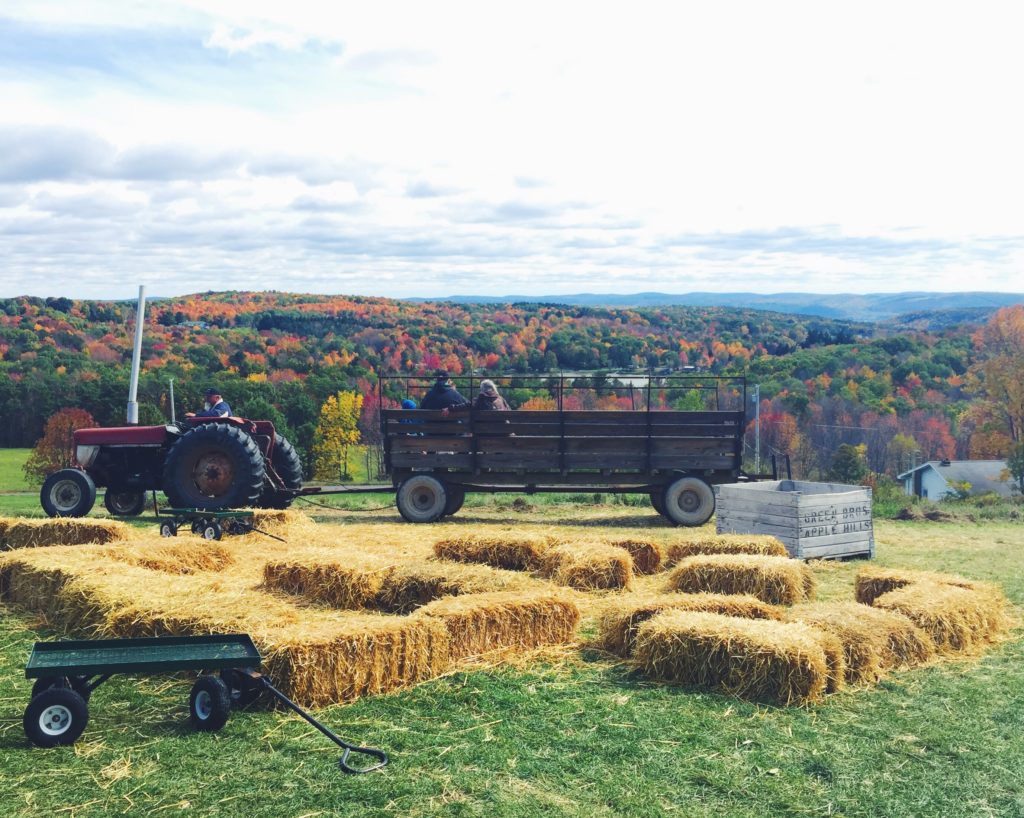
- Provide hand sanitizer on the wagon.
- Sanitize handrails and surfaces between trips.
- Designate a waiting line for customers to queue with 6-foot distances clearly indicated.
- Alternative: Create walking paths, with signs that describe the farm, to allow folks to have a farm tour without a wagon ride. This is a great way to highlight your history and crop production.
Children’s Play Areas Not Allowed
According to NY Forward guidance, it is mandatory to “close children’s play areas or exhibits with play equipment, unless such areas/exhibits can be cleaned, disinfected, and sanitized between each child using the area/equipment who is not a member of the same household or party.”
- Bales can be made available for photographic opportunities, but not for play. Do not build structures with straw bales that invite kids to play in these areas.
- If you want to open a play area, you must consult with your regional control board for approval.
Corn Mazes
Because corn mazes, by nature, will require people to travel possibly in two directions in aisles, they will not be able to observe physical distancing. For this reason, you must reduce and monitor the number of people in the maze at any one time and be certain everyone is wearing a cloth face covering. Estimate the number of groups that may be allowed in the maze at any one time, as follows:
Calculate the number of people allowed in the maze at any one time to ensure physical distancing. Since people only travel in the paths of the maze, estimate the percent of the area that are paths, then divide that area by 250 for groups (assuming each group has about 4 people that need to be distanced from other groups). For example:
-
- If your corn maze is 200’ by 200’, that is 40,000 square feet.
- Of that space, estimate that 20% is devoted to the pathways people will walk (i.e., 40,000 x .20). The pathways would equal 8000 square feet.
- Divide this area of pathways by 250 (i.e., 8000/250). In this case that would equal 32 groups in the maze at one time.
- Designate a roped waiting aisle with 6-foot distancing marked.
- Post employees with phones/walkie talkies at the entrance and exits of mazes to regulate the number of visitors in the maze.
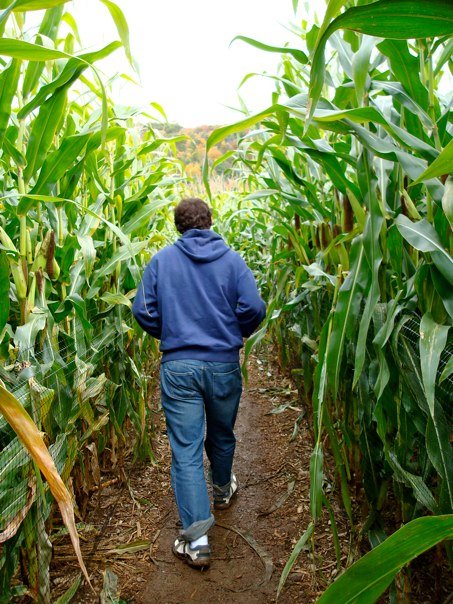
- Require face coverings to be worn at all times in the maze. Customers may be walking in two directions in an aisle, so physical distance may not be maintained. Face coverings will reduce risks during these short intervals.
- Place employees in the maze to make sure that face coverings are being worn and to help groups navigate safely.
U-Pick (e.g. Pumpkins, Apples, Christmas Trees)
- Refer to the U-pick best management practices previously published (link provided below) to manage customer distancing and flow.
- Offer more pre-picked crops to accommodate reduced numbers in the orchard.
- Place checkouts at each U-pick block to manage payments.
- Per NYS Department of Agriculture and Markets Frequently Asked Questions around AgriTourism activities guidance, customers are not allowed to consume and dispose of apples in orchards.
Petting Farms Not Allowed
- Convert any previous petting zoo areas to animal viewing only.
- Place markers or flagging tape on fences to support 6-foot physical distancing among visitors.
- Consider other contact-less feeding options, such as bucket pulleys.
- Place employees near the exhibit to manage customer flow.
Picnic Areas
- Restrict access to the picnic areas to only those seated at tables by roping off areas and maintaining one entrance and exit.
- Designate an employee to monitor picnic tables and areas.
- While the NYS Guidance requires tables to be placed at least 6 feet apart, this distance may not be sufficient to allow for flow of customers walking among tables.
- In no instance, may a table exceed 10 people.
- Consider use of plastic tablecloths to facilitate cleaning and sanitizing between groups.
- Sanitize tables between groups.
Tastings (Food or Beverages)
- If licensed to serve alcoholic beverages, stay up to date to guidelines from the NYS Liquor Authority.
- Consult the Cornell Craft Beverage Guidance for additional details on managing tasting rooms.
- If possible, provide different routes for entry and exit into food retail or tasting areas and label them clearly.
- Place an employee at the entrance to greet customers and briefly explain the traffic flow. One or more employees should be placed in the tasting area to monitor physical distancing.
- Create a one-direction foot-traffic pattern for customers to walk through the tasting area.
- Clearly label tasting areas, ideally marking surfaces to show tasting locations.
- Assign a specific tasting space to each customer, emphasizing the importance of staying at their table or bar space. Emphasize that groups should stay close to each other.
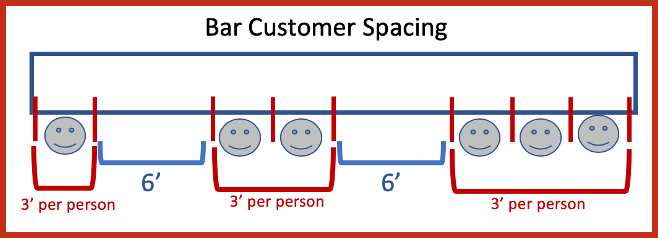
- Encourage customers to use the toilet before or after their tasting, to limit trips back and forth.
- Employees must maintain a 6-foot distance from customers at check-out.
- Designate one employee to process payments.
- Consider installing clear plastic shields or dividers between employees and customers.
- Hands should be washed or sanitized between transactions, and gloves should be used if feasible. (See instructions on glove use, above).
- Remember that ticketed musical concerts are not allowable at this time. Only incidental music (e.g., unadvertised, unticketed performances) that might enhance the farm experience are allowed.
4. Provide additional handwashing and hand sanitizing opportunities and restrooms for employees and customers.
Provide more hand washing stations (i.e., soap, water, single-use towels) or hand sanitizer (i.e., minimum 60% ethanol or 70% isopropyl) for customers.
- Install a hand sanitizer dispenser and signs encouraging its use, just outside your entrance; place others near farm activities and especially near and food service or picnic areas.
- Build free-standing handwashing stations: https://bit.ly/3lKRFiT or https://bit.ly/3buwqfL
- Ensure that restroom facilities have functional and well-stocked handwashing sinks.
- For porta-potties:
- Provide soap, water and single use paper towels for handwashing, and provide hand sanitizer.
- Provide a garbage can lined with a trash bag for used paper towels.
- Make sure these are anchored and have foot-operated lid, if possible, to minimize litter.
- Replace these liners daily.
- Post signs emphasizing importance of handwashing after using facilities.
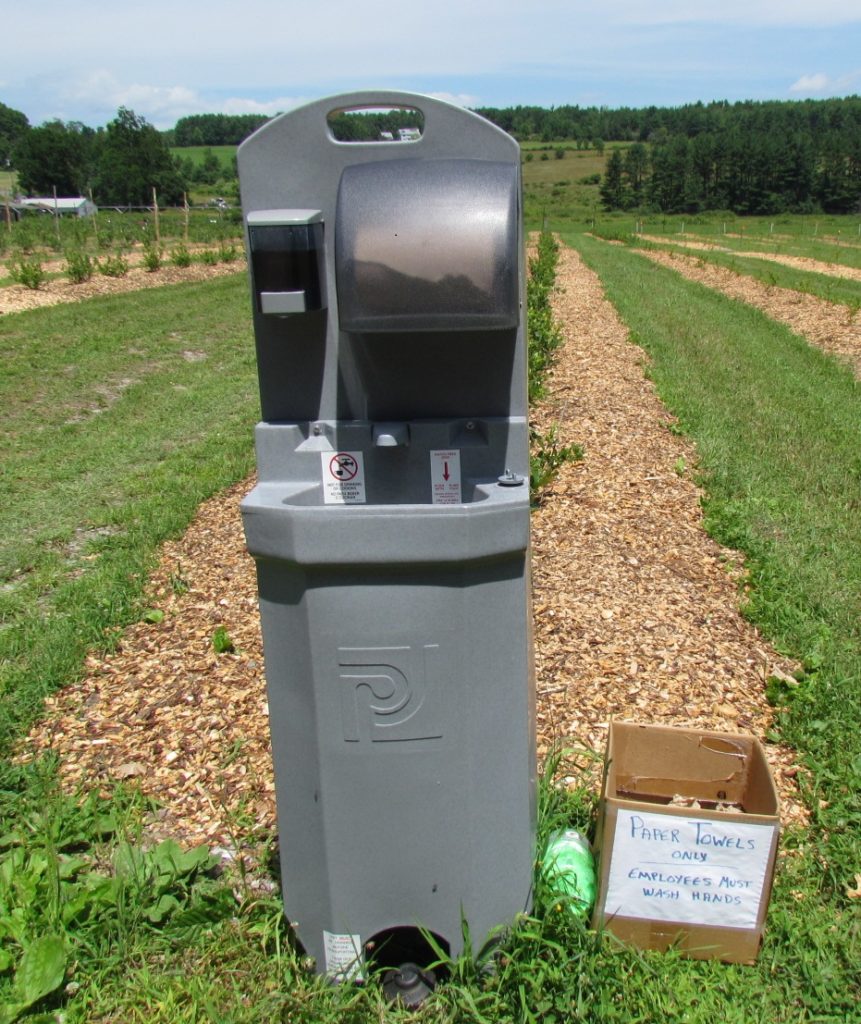
5. Increase the frequency of cleaning and sanitizing frequently touched surfaces.
Areas that see high traffic or frequent touching, like doors, light switches, tables, chairs, cart and basket handles, credit card machines, handrails, and bathrooms must be cleaned and sanitized several times a day.
- Identify high traffic and high-touch surfaces in around the farm and create a standard operating procedure (SOP) for each. An example SOP can be found here: https://bit.ly/3eMw7ic.
- Create a schedule and checklist to verify regular cleaning and sanitizing.
- Assign one or more employees to cleaning and sanitizing during each shift.
- Train employees on sanitation SOPs.
- Use non-porous tables and/or plastic table cloths on wooden tables since these surfaces are easier to clean and sanitize.
Follow this four-step process for cleaning and sanitizing high-touch surfaces:
- Remove visible dirt and debris.
- Wash with soap and water or appropriate detergent.
- Rinse the surface of debris and detergent.
- Sanitize with a food contact surface approved sanitizer.
- For a list of materials visit: https://bit.ly/2Y0EalM.
- Verify that the product is registered for use in your state and region: https://bit.ly/2VNEkdo.
- Follow the label and observe any recommended contact times required for the sanitizers to be effective (e.g., 2 minutes).
- Remember that concentration of active ingredient will differ between products, for example, some bleach productions may contain 6% active ingredient, others 12%. Use one of these dosage calculators to calculate the amount of product needed:
- Sanitizer Dosing Calculator: https://bit.ly/3cJSR0m
- Bleach concentration calculator: https://bit.ly/2WtWSjb
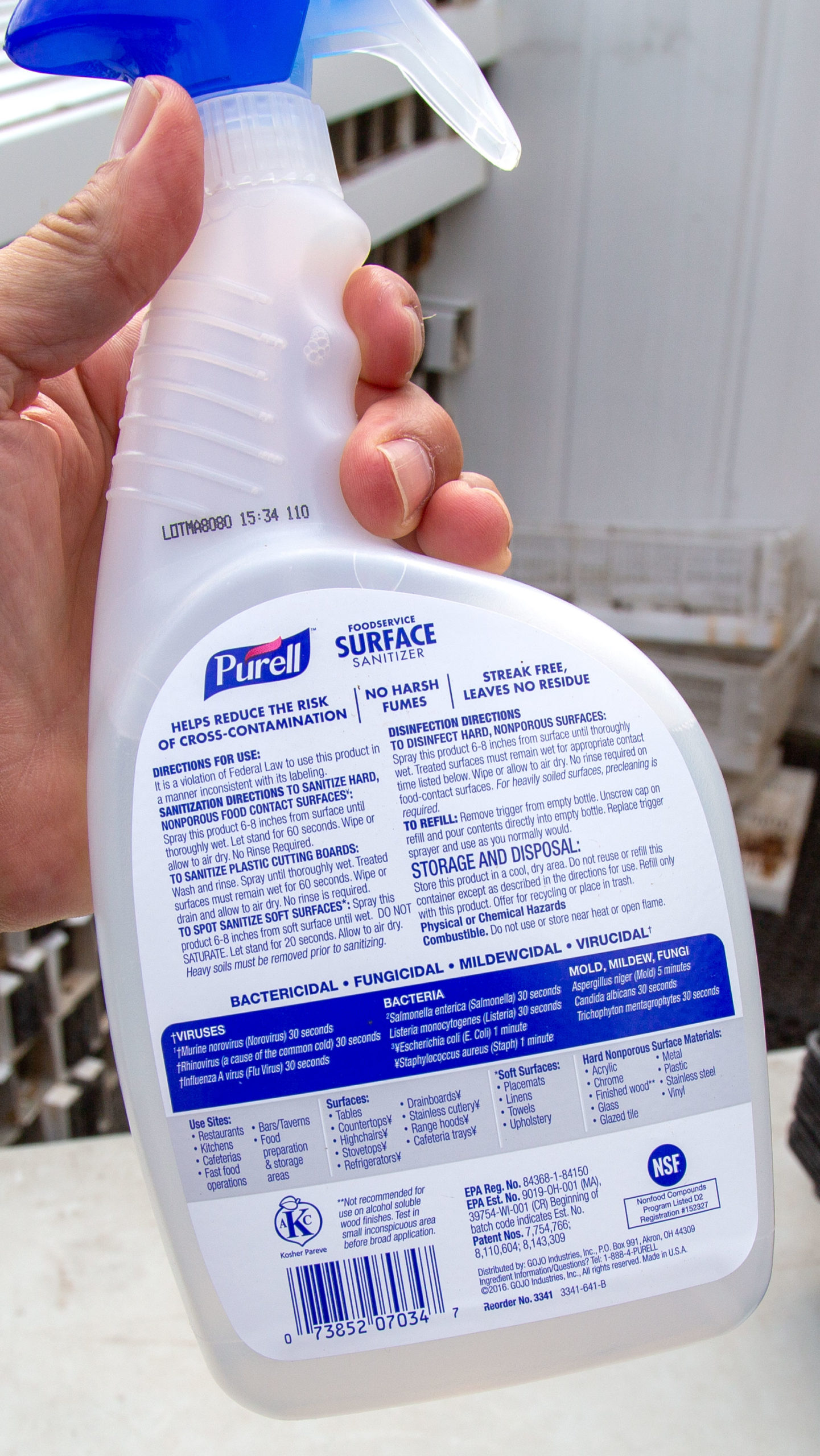
- Clean and sanitize the credit card units and sales equipment twice daily.
- Ideally use protective plastic coverings to support ease of cleaning.
- Use 70% isopropyl alcohol wipes.
- Do not spray with sanitizer solutions.
- Perform regular toilet cleaning several times per day, paying special attention to sanitizing all door handles, power switches, faucets and toilet handles.
- Consult the EPA N-list for other disinfectants for use against coronavirus: https://bit.ly/3f1PxA3
Sanitizers
The Produce Safety Alliance has a fact sheet with information on how to select a sanitizer. Each product’s label provides detailed usage instructions. Ultra Clorox Disinfecting Bleach and Sanidate 5.0 are two examples of sanitizers commonly used on the farm.
Ultra Clorox Disinfecting Bleach (EPA #5813-111); Active Ingredient: 6% Sodium Hypochlorite
- When sanitizing clean food contact surfaces, use 2 teaspoons of product per gallon of water to prepare a 150 ppm available chlorine solution. Let stand 2 minutes and air dry. The exact concentration of chlorine should be checked with test strips.
- Instructions for sanitizing non-food contact surfaces can be found on page 15 of the label.
- Learn more.
Sanidate 5.0 (EPA #70299-19); Active Ingredients: Hydrogen peroxide (23%) and Peroxyacetic Acid (5.3%)
- When sanitizing non-wood, clean food contact surfaces, use 1.6 to 5.4 fl. oz. of product to 5 gallons of water (147-500 ppm peroxyacetic acid solution). Treated surfaces must remain visibly wet for 1 minute. Allow items and/or surfaces to drain before using. Do not rinse.
- Instructions for sanitizing non-food contact surfaces can be found on page 11 of the label.
- Learn more.
6. Stay up-to-date on COVID-19
Frequently review the CDC’s COVID-19 guidance and be prepared to modify COVID-19 operating protocols to reflect new information on best management and safety practices.
- Consider assigning vulnerable workers to duties that minimize contact with customers and other employees (e.g., managing inventory, performing administrative work from home).
- Employees with COVID-19 symptoms must report to their supervisor.
- Sick employees must be sent home immediately.
- Clean and disinfect all surfaces at their workspace before other employees work in that area.
- If a worker is confirmed to be COVID 19 positive, other workers should be informed of their possible exposure, while maintaining patient confidentiality.
- Sick employees must stay home and follow the CDC’s What to do if you are sick with coronavirus disease 2019 (COVID-19), as well as directives from the local health authority.
- Instruct employees who are well but know they have been exposed to COVID-19 to notify their supervisor, self-monitor for symptoms, and follow CDC-recommended precautions.
Taking these proactive steps will protect your team and your customers and create a positive farm experience during this pandemic.
We are in this together.
References:
- NYSDAM COVID-19 Agritourism Frequently Asked Questions
- NY Forward Business Safety Plan Support for Farms
- Best Management Practices for U-Pick Farms During the COVID-19 Pandemic
- NYSDAM Interim Guidance for the Operation of Farmers’ Markets
- Best Management Practices for Craft Beverage Tastings During the COVID-19 Pandemic
- Phase 3/4 Guidelines for Licensed On-Premises Establishments
- NY Forward Low Risk Outdoor Arts and Entertainment Guidelines
- NYS Department of Health Information on Coronavirus
- NYS COVID-19 Travel Advisory
- Interim Guidance for Public Transportation Activities During the COVID-19 Public Health Emergency
These recommendations were prepared by:
Anusuya Rangarajan, Elizabeth Bihn, Marvin Pritts, Julie Suarez and Kacey Deamer, College of Agriculture and Life Sciences, Cornell University.
Laura McDermott and Barbara Neal, Cornell Cooperative Extension.
Elizabeth Lamb, NYS Integrated Pest Management Program.


